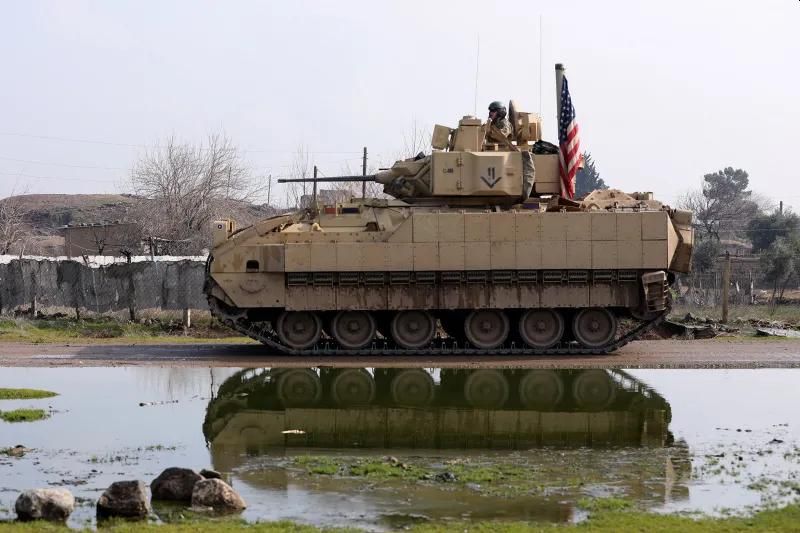By Eric Vandenbroeck and co-workers
Why Washington Should Create the
Conditions to Withdraw U.S. Troops
The shocking, sudden
fall of Bashar al-Assad’s regime at the hands of the Islamist group Hayat
Tahrir al-Sham has prompted jubilation among Syrians who suffered 13 years of
civil war and decades more of oppressive rule. But as a new government takes
shape in Damascus, Syrians and foreign observers alike worry about how
inclusive, representative, and Islamist it may be. The country’s de facto
leader, Ahmed al-Shara, is a former al Qaeda militant, although he claims to
have renounced terrorism. HTS itself is designated a terrorist organization by
the United States. And there are fears that unresolved tensions between Syria’s
ethnic and religious groups could impede Shara’s efforts to unify the country
and consolidate his rule.
Choices that the
United States makes in the near term will affect the ability of the new regime
to extend its writ throughout Syria and rebuild. As
Washington considers how to respond to the change in government, there are
reasons to give Syria’s new leaders the benefit of the doubt. One is the dire
state of the war-torn country: more than 70 percent of Syrians are living below
the poverty line, Syria’s GDP has fallen from $60 billion to $10 billion since
2011, and the cost of reconstruction is projected at $400 billion. Shara has
also demonstrated his ability to adapt to new circumstances. After capturing
Syria’s Idlib Province in 2017, he proceeded to build a proto-state from
scratch, expelling many foreign fighters from HTS to embrace a Syrian
nationalist agenda. He disavowed previous jihadist ambitions to win the
military and financial support of Turkey and Qatar, which enabled HTS’s
eventual march to Damascus. Shara also reached out to the province’s small
Christian and Druze communities and embraced women’s education, opening the
door for humanitarian assistance from Western states and nongovernmental
organizations.
Perhaps most
pertinent for Washington, the United States’ objectives in Syria have largely
been met. Assad’s rule is finished. The Iranian and Russian troops that
supported the regime have withdrawn from the country. For Iran, in
particular, the loss of a friendly government in Syria is a significant blow:
Tehran has lost its main route for shuttling arms to Hezbollah in Lebanon, and
thus its path to rebuild its severely weakened “axis of resistance.” U.S.
forces and the U.S.-backed Syrian Democratic Forces (SDF), a Kurdish militant
group based in northern Syria, have also badly damaged the Islamic State, known as ISIS. Washington no longer has a
pressing need to maintain its military presence or the crushing sanctions that
were initially designed to incapacitate the Assad regime.
The best outcome for
Syria and its neighbors is a unitary, cohesive state that can negotiate and
deliver on diplomatic agreements that foster long-run regional stability. The
alternative is a weak, divided, and conflict-prone Syria—an outcome that would require
a longer-term and increasingly costly U.S. military presence in the region,
create problems for Turkey (a U.S. ally), jeopardize a delicate
rebuilding process in Iraq, and generate another wave of Syrian emigration. To
avoid that scenario, the United States should give the new Syrian government a
chance. It should withdraw its troops from the country, allowing Damascus to
regain control of the agricultural and oil-rich provinces in Syria’s northeast.
First, however, Washington needs assurances that Shara and HTS have the
capacity and will to keep ISIS in check and that the new government will
guarantee the safety and inclusion of Syria’s Kurds, if necessary distancing
itself from Ankara to do so. Using the leverage at its disposal—including a
commitment to lift sanctions, which will permit foreign investment in Syria and
give the government access to the international banking system—Washington can
convince Shara’s government that cooperating to facilitate a U.S. military
departure is in its best interest.

A U.S. tank in the countryside of Qamishli, Syria,
February 2024
Bring Them Home
The United States
should plan to remove the approximately 2,000 forces currently deployed in
Syria. U.S. troops served several purposes while the country was mired in civil
war: they interdicted Iran’s access to Syrian territory to resupply Hezbollah
in Lebanon, cut off the Assad regime’s access to oil fields in rebel-held
territory, deterred attacks on the SDF by Turkey or its proxies, and worked
with the SDF to defeat ISIS, a mission that
the Pentagon reaffirmed in
December 2024. These efforts also helped establish Rojava, a quasi-independent
state in the Kurdish region in Syria’s northeast. This region, along with the
Deir ez-Zor governorate, holds most of Syria’s oil and gas wells, which U.S.
forces have controlled since 2019. It is also where some 20,000 ISIS fighters
remain jailed inside detention centers, along with 60,000 women and children.
Most U.S. objectives in Syria have been accomplished: Iran’s access to Lebanon
through Syria has been stanched, Assad is out, and the ISIS caliphate has been
crushed. Only the fate of Syrian Kurds remains unresolved.
Withdrawing American
forces from Syria would do little to change Washington’s overall military
posture, as the current deployment to Syria represents an infinitesimal
fraction of the United States’ 614,000 active-duty and reserve soldiers and
marines. If Washington prefers to see Syria weak and divided, a garrison of
2,000 troops is arguably an economical approach to keeping it that way. But if
it wants the new Syrian government to be capable of alleviating the current
humanitarian crisis, controlling the country’s borders, and beginning the
process of reconstruction, maintaining a U.S. troop presence in defiance of the
wishes of that government will be counterproductive. Maintaining the status quo
could be far more dangerous than withdrawal. If the new government were to
challenge the continued U.S. presence, American troops would be killed, and
Washington could be forced to commit to a larger deployment. Cornered Syrian
authorities might seek the help of Turkey or even Russia, and escalation would
follow. But if Washington instead makes a deal that includes the departure of
U.S. troops, it could win concessions from the new Syrian government that
advance U.S. military objectives, including the security of Syrian Kurds.
U.S. withdrawal could
help Syria’s economic recovery, as well. This process would entail handing
control of oil fields to the new Syrian government, which could ramp up output
and reap immediate economic rewards. The United States could enlist
Saudi Arabia and the United Arab Emirates in the effort to increase oil
production, a step that would both redound to Washington’s benefit in future
negotiations and transform the Syrian economy by providing steady employment in
the oil sector and other industries that depend on it, which could entice
refugees in Jordan, Lebanon, and Turkey to return to their homeland.

A Diplomatic Knot
The fate of the
Syrian Kurds is a potential sticking point in a negotiated departure of U.S.
forces. After the Assad regime fell, the Kurdish administration in northeastern
Syria swiftly raised the opposition flag, and Shara assured the Kurds that they
were an essential part of the country and would not face persecution. Yet given
HTS’s ties to Ankara and the persistent animosity between Syrian Arabs and
Kurds, there are credible fears that the new Syrian leadership might permit a
concerted Turkish attempt to suppress the SDF and ravage Kurdish areas.
Defenders of the SDF have argued that U.S. abandonment of the Kurds in Syria
would be not only an indelible moral stain on Washington’s reputation but also
a strategic mistake that would weaken allies’ belief in U.S. reliability,
encourage Turkey’s regional ambitions, and embolden the remnants of ISIS.
The United States
must convince the SDF that the best bet for Syrian Kurds is to integrate with
the new government, as Shara has urged. U.S. policymakers will also need to
persuade Ankara to accept this outcome. Turkey considers the SDF a terrorist
organization aligned with the Kurdistan Workers’ Party, or PKK, a militant
group that has been fighting Turkey for decades and that both Turkey and the
United States have declared a terrorist organization. Ankara maintains that
militants affiliated with both groups in northern Syria pose a threat to its
security, and those concerns cannot be disregarded: Turkey is a NATO ally and
therefore has a claim on U.S. support.
For years, U.S.
leaders have struggled to keep the peace between the Syrian Kurds, who have
been critical allies in the fight against ISIS, and Turkey. In his first term,
President Donald Trump initially promised Turkish President Recep
Tayyip Erdogan a free hand to subjugate the Kurdish region of northern Syria
before reversing his decision and reaffirming the U.S. commitment to Kurdish
autonomy. In 2020, Trump sought to remove U.S. troops from Syria but failed in
the face of pushback from the Pentagon and members of Congress. In December
2024, after the HTS push into Aleppo, the president-elect wrote on
Truth Social: “The United States should have nothing to do with [Syria.] This
is not our fight.” With the civil war now concluded, Trump would presumably
favor drawing down U.S. forces in the country.
Any U.S. troop
withdrawal must include a plan to leverage Syrian Kurds’ territorial gains and
U.S. control over oil fields in exchange for the new regime’s promise to
protect the country’s Kurds from Turkey’s aggression. A deal might stipulate,
for example, that the SDF would retreat to Kurdish population centers and
cooperate with the yet-to-be-constituted Syrian national armyin
Kurdish areas, an important signal of good faith. And the United States could
condition the return of Syria’s oil fields to the government in Damascus on
Shara’s demonstration of his willingness to protect Syrian Kurds from Turkish
attacks and his ability to defend the fields from ISIS attacks.
Ankara, too, would have to be assured that the new Syrian government,
potentially with the assistance of a multilateral monitoring and verification
effort, could prevent militants in its territory from threatening Turkey.

Worth the Risk
Creating the
conditions for a smooth U.S. withdrawal from Syria is no small task. Not
only would Shara and HTS need to take over the military campaign against ISIS
and reach a resolution with the Syrian Kurds, but the new government might also
need to eschew the overtures of powerful neighbors, as well as the demands of
extremist factions within Syria, to meet Washington’s requirements. To
facilitate a workable arrangement, the United States will need to provide
Damascus with relief from the sanctions on the Assad dynasty that have been in
place since 1979. Economic measures meant to squeeze the dictator
have punished ordinary Syrians, who lack access to electricity and clean water,
a transportation network, health care, education, a functioning agricultural
sector, and timely humanitarian aid. As long as sanctions remain in place,
economic development and employment will remain stunted, decreasing the chances
of success for Syria’s new government and increasing the likelihood of violent
disorder, foreign intervention, and additional emigration.
Sanctions against the
Assad regime are separate from those targeting HTS,
which are based on the group’s terrorist designation. Washington should ignore
the inevitable drumbeat from advocates of economic pressure to keep these
sanctions in place or to levy new ones, and waive the current restrictions
instead. In the meantime, to guard against possible human and civil
rights abuses by the new government, the United States should work with other
countries in the region that may hold sway with Syria’s leaders to ensure that
the regime understands the crucial importance of quelling retributive violence
and respecting the rights of secular and minority Syrians. Recognizing that
some level of turmoil is inevitable while the government consolidates its rule,
the United States, in the absence of egregious atrocities, should grant a
six-month grace period in which it refrains from reinstituting old sanctions or
imposing new ones.
The United States has
considerable leverage over the main actors in the new Syria. Shara understands
how useful U.S. support would be to legitimize his rule, to secure the
resources necessary for stabilization and reconstruction, and to help Damascus
rebuff other countries that may try to pursue their own interests in Syria.
With the United States working against Syria’s government, the country would be
vulnerable to military pressure from Turkey and Israel, lack access to
domestically produced oil, struggle to arm and feed a professional military,
and face a separatist Kurdish region. Turkey, for its part, understands that if
U.S. forces stay in Syria, Ankara’s relationship with Washington will remain
strained and de facto Syrian Kurdish autonomy will continue to frustrate
Turkish security goals. As for the Syrian Kurds, the ball is in the United
States’ court, but Washington must make clear that its goal is to leave the
Kurdish region under the authority of a central government in Damascus that
respects the rights and safety of its residents.
Even if Washington is
able to win the cooperation of Syria’s new leaders, protect Syrian Kurds
without drawing the ire of Ankara, and keep ISIS disempowered, all while
reducing the U.S. footprint in Syria, it still may not be enough to avert a
regional conflagration. Israel and Turkey both hope to carve out spheres of
influence in Syria. In the chaos of the past few weeks, the Israeli military
has already seized a swath of territory on the Syrian side of a 1973 cease-fire
line. Turkey, meanwhile, has taken control of a long buffer zone on the Syrian
side of the countries’ shared border. The context for these moves is troubling:
in September, Erdogan urged the UN General Assembly to authorize the use of
force against Israel because of its conduct in Gaza. Should the new Syrian
authorities give Turkey access to military bases in the country—especially
those between Damascus and the Golan Heights, a move Israel would regard as
threatening because of the area’s proximity to Israeli forces and territory—a
clash between Israel and Turkey would be a serious possibility.
But by negotiating
the terms that would enable a U.S. military withdrawal from Syria, Washington
can avoid another calamitous outcome: a continued U.S. troop presence combined
with a lack of measures to help stabilize the new Syrian government could lead
to an increasingly costly U.S. mission in a country that is not at the center
of Washington’s global strategic concerns. Withdrawal could relieve the United
States of a secondary security responsibility; empower the new Syrian
government to stave off intervention by Iran, Turkey, or even Russia on its
own; and keep in place the formal and informal arrangements that have
maintained peace between Israel and Syria for decades. Handing the reins of oil
production over to Damascus could also help the new government manage an
economy that can absorb a substantial number of returning refugees. Trusting a
regime with a limited track record is a gamble. But should Washington’s bet not
pay off, the result—a Syria in which the United States has few contacts and
little influence—would be a return to the status quo ante, with the United
States hardly worse off than it is now. And after more than a decade of
disorder—and untold levels of suffering by Syrian civilians—the upside is worth
the risk.
For updates click hompage here